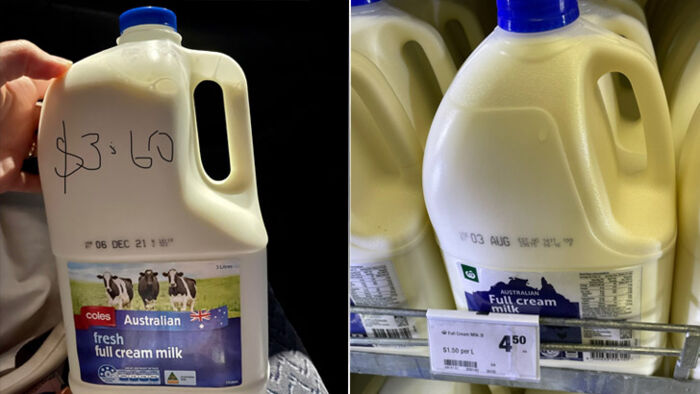The price of milk: How to counter the rising cost of dairy
By Serina Bird
Milk. Eggs. Bread. Three staples are a mainstay of our supermarket trolley for many of us. And when these things rise, we feel the pain.
We have long enjoyed low milk prices at the supermarket. This has been a good thing for consumers, but not for farmers.
One of my cousins lost the family dairy farm a few years ago amidst drowning debt. The whole issue of the price of milk has been a complicated, contested, and politicised space for a long time. And now, the prices are really starting to rise.
My friend Misty Henkel has been watching the price of milk rise and sharing milk photos online. Her family of two boys drinks a lot of milk.
She noticed that a 3-litre bottle of fresh milk went from $3.30-$3.60 ($1.10 - $1.20 a litre) in November 2021 to $4.50 ($1.50 a litre) in July 2022. And it's up to nearly $10 for 3 litres for specialty milk such as a2.
That might not seem like a lot, but for many families struggling, it adds up - especially if a family are big milk drinkers. And the price is not likely to reduce anytime soon with ABARES and Dairy Australia forecasting farmgate milk prices in Australia will by 28% in 2022-23, representing the equal highest farmgate milk price on record since 2000.
Ouch. And with supply chain issues, that's if you can even get certain dairy products.
So, what can you do to counter the growing cost of dairy?
1. Make your own yoghurt.
It is surprisingly easy to make your own yoghurt. There are many yoghurt makers on the market (my breadmaker even includes a yoghurt-making function), but with some youtube sleuthing you can make your own using an esky or another warm environment.
Simply make up 1 litre of milk from powdered milk, stir in two tablespoons of yoghurt (or yoghurt-making mix) and allow to sit in a warm place for around eight hours.
Cost: $1.14 a litre compared with around $4 of commercial yoghurt.
2. Milk powder
At around $8 a packet, a litre of milk made up from powdered costs $1.14. This might not seem like a big return on investment, but the real value is using milk powder mid-week to prevent extra trips to the shops.
Every time you get in your car and drive to the supermarket it costs time and money. And when you are trying to find the milk in the far corner, it's likely you will be tempted by other items.
Not everyone likes the taste of milk made from milk powder, although oddly, my children prefer it and think of it as a treat.
You can, however, top up some fresh milk with milk made from powdered milk; shake and leave overnight and in the morning it will taste like fresh milk. I also use milk powder in cooking everything from cakes to pancakes, as well as in smoothies.
Actually, I now prefer it in cooking as I find it is more stable and easier to use.
Cost: $1.14 a litre compared with $1.50 a litre, plus savings on petrol and time
3. Make your own cheese
If you can make yoghurt, you can make cheese.
Make a simple labna-style cream cheese by balling yoghurt up in cheesecloth or a clean chux and allowing it to hang overnight. Or use a sieve with a weight on top.
You can also make cottage or ricotta cheese by boiling 1 litre of milk with a tablespoon or lemon juice, yoghurt or vinegar and separating the curds and weight. Hint: keep the leftover whey and use it to make pancakes or smoothies.
Cost: $1.14 compared with $3.20 for 250g of cream cheese
4. UHT milk
Rather than using fresh milk, try UHT.
It keeps for longer, which reduces waste, and doesn't require refrigeration until it is opened. It used to be cheaper than fresh milk, but recently costs have gone up making it slightly more expensive. But you still save petrol, time and effort as it lasts for longer.
Look for sales when UHT is on special.
Cost: $1.60 plus compared with $1.50 a litre, with savings on petrol, refrigeration and time
5. Soy milk
Challenging times call for radical efforts, and one of these is making your own milk.
I'm not talking about having a cow in your backyard, but rather making your own soy milk. Fresh soy milk is a staple breakfast item in many Chinese communities.
You can buy specialty machines to make it for you, or you could make it yourself from soybeans.
Soak soybeans overnight, pulverise them with water in a food processor or blender, strain through a pillowcase, and cook until boiling, skimming thick bubbles from the top.
The resulting soy milk is healthy and traditionally enjoyed hot and sweet. But you can use it for things like over cereal or even in tea or coffee. It might not be to everyone's taste, but there are definitely cost savings. Hint: keep the leftovers and use it when baking bread.
Cost: between 35c to 50c for 100g
Get stories like this in our newsletters.



